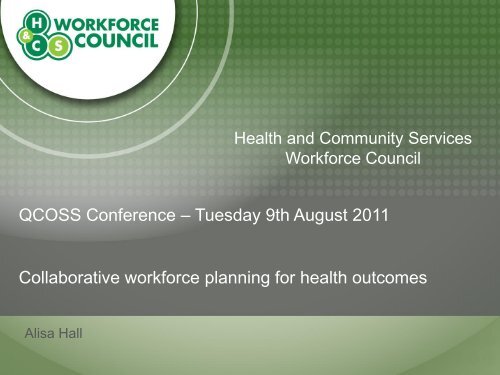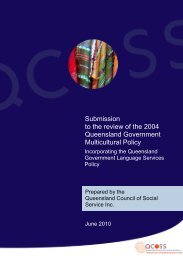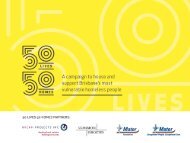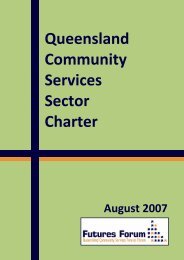Alisa Hall - Queensland Council of Social Service
Alisa Hall - Queensland Council of Social Service
Alisa Hall - Queensland Council of Social Service
Create successful ePaper yourself
Turn your PDF publications into a flip-book with our unique Google optimized e-Paper software.
Health and Community <strong>Service</strong>s<br />
Workforce <strong>Council</strong><br />
QCOSS Conference – Tuesday 9th August 2011<br />
Collaborative workforce planning for health outcomes<br />
<strong>Alisa</strong> <strong>Hall</strong>
Workforce <strong>Council</strong> –<br />
Leading Workforce Innovation<br />
• Undertake, promote and advocate for workforce planning<br />
and development to ensure workforce quality and<br />
sustainability<br />
• Partnership and collaboration - more than forty regional<br />
and state-wide industry networks across <strong>Queensland</strong> to<br />
roll out workforce planning and management strategies<br />
and actions underpinned by a grass roots capacity<br />
building
Looking to the future<br />
• The working-age population is falling as demand for health and<br />
community services continues to grow<br />
• In the last decade, employment in the Health Care and <strong>Social</strong><br />
Assistance industry increased by 51.5 % - the largest growth over<br />
this period<br />
• Health and <strong>Social</strong> Assistance employment is expected to grow at<br />
4.5% pa until 2015/16. National average 2.1% pa<br />
• This equates to 323,300 new jobs (almost one in four new jobs)<br />
over the next five years.
11.5%
Community <strong>Service</strong>s –<br />
Major Drivers / Workforce Issues<br />
• Remuneration disparity between public and non government sector<br />
• Attracting sufficient skills and labour.<br />
• Increased competition for labour and skills.<br />
• High turnover <strong>of</strong> staff.<br />
• Increased service demand, increased workloads and increased stress at all levels<br />
within organisations.<br />
• Limited resources and capacity to invest in training and workforce planning &<br />
development.<br />
• Management and leadership capacity.<br />
• Instability <strong>of</strong> workforce – casual and part-time nature <strong>of</strong> many roles.<br />
• Limited availability <strong>of</strong> workforce to deliver care which is aligned to a culturally diverse<br />
population<br />
• New service models requiring new skills and role redesign.<br />
• Role redesign and engagement models required to attract and retain a changing<br />
volunteer pr<strong>of</strong>ile.<br />
• Requirement for higher level skills, in particular mental health, housing and<br />
homelessness.<br />
• Poor reputation <strong>of</strong> VET and VET qualifications in some sectors.
Question<br />
Are there others?
Health Reforms - the<br />
<strong>Queensland</strong> breakdown<br />
‣ Local Health and Hospital Networks (LHHN)<br />
<br />
<br />
<br />
17 in total for Qld, 1 July 2012 start<br />
Statutory Authorities<br />
Bill taken to Parliament 16 June 2011 – consultation closed 31 July<br />
‣ Medicare Locals (ML)<br />
11 in total → 5 announced for 1 July 2011 start<br />
Next phases - 1 January 2012 and 1 July 2012<br />
<br />
<br />
Largely organisation based membership<br />
Companies Limited by Guarantee<br />
‣ Alignment between boundaries (largely) – Some ML have multiple<br />
LHHN’s in area
Medicare Locals – the basics<br />
‣ New organisations with broader roles<br />
‣ Strengthen and integrate the primary health care<br />
(PHC) system – coordinate; access; connection<br />
‣ Focus on the health needs and primary care services<br />
<strong>of</strong> local community<br />
‣ Governance – Skills-based boards; planning and<br />
engagement mechanisms<br />
‣ Different models in different regions<br />
‣ Population Health Planning; after-hours Primary<br />
Medical Care
What does it all mean –<br />
considerations and concerns<br />
‣ Who is the PHC workforce ?<br />
‣ How will LHHN and ML’s<br />
interface ?<br />
‣ What about ‘non clinical’ staff ?<br />
‣ What happens in the future ?<br />
→ will ML be the fund holder<br />
‣ How do peaks, organisations link<br />
in and engage ?<br />
‣ Will existing infrastructure (i.e. services) be harnessed and<br />
strengthened ?<br />
‣ Where does private sector fit ?<br />
‣ What about clinical training networks, lead clinician<br />
groups, compact
Workforce implications<br />
‣ We will need a workforce who can:<br />
Collaborate and engage across a range <strong>of</strong> disciplines and<br />
domains to ensure integrated delivery<br />
Equip themselves to proactively identify and pursue<br />
improved models <strong>of</strong> service delivery and patient-centred<br />
care<br />
‣ Different development needed for different workforce<br />
components<br />
‣ Training and skill development will be needed – but that’s not<br />
all… relationship management, knowledge management and<br />
transfer systems, clinical and systems leadership; governance<br />
(layers); appropriate org/regional policies and protocols….
Question<br />
Do you think health reform affects you / your<br />
organisation
We can roll the dice and see what<br />
happens… or we can…<br />
• Step back<br />
• Take a look at where we’re at<br />
• Take a look at where we want to be<br />
• Make a plan for how to get there<br />
• And build our capacity together to walk down that road….<br />
A CAPACITY BUILDING APPROACH TO WORKFORCE PLANNING
The right<br />
number <strong>of</strong><br />
people<br />
Interacting<br />
in the right<br />
ways<br />
With the<br />
right skills &<br />
capabilities<br />
Organised<br />
in the right<br />
ways
Workforce Planning and Development<br />
Responding to Issues at various levels to achieve change<br />
Broader<br />
Systems<br />
&<br />
Structures<br />
Regional & Sector<br />
Community<br />
Systems<br />
&<br />
Structures<br />
Organisational<br />
Systems<br />
&<br />
Structures<br />
Individual
Why Strategic Workforce<br />
Planning?<br />
There must be alignment<br />
across a range <strong>of</strong><br />
Industries and sectors that<br />
form part <strong>of</strong> the systems<br />
that impact on health<br />
outcomes for the<br />
community.<br />
Achieving alignment at<br />
systems and regional<br />
levels requires alignment<br />
between organisations<br />
and the individuals who<br />
make up those<br />
organisations<br />
Org<br />
Industry / Sector<br />
Org Org Org Org Org Org
Workforce Planning
Continuous Cycles<br />
‣ Workforce planning should be conducted in<br />
continuous cycles<br />
‣ Each cycle ensures that:<br />
the evidence-base is improved over time<br />
the currency <strong>of</strong> the plan is maintained<br />
discrete workforce issues can be explored and<br />
addressed in greater depth<br />
new stakeholders are continuously engaged in<br />
the process providing potential for greater impact
The possibilities<br />
• Shared regional workforce vision - regional whole <strong>of</strong> system<br />
workforce planning<br />
• More accurate whole <strong>of</strong> system workforce data for PHC –<br />
powerful to inform planning<br />
• Joint recruitment (productivity)<br />
• Supervision models which harness regional workforce<br />
• Workforce better distributed to meet need<br />
• Joint skilling and training<br />
• Pooled resources to gain efficiencies<br />
• Job design that allows mobility across the region<br />
• Identification <strong>of</strong> workforce measures beyond job and vacancy<br />
numbers, years <strong>of</strong> service etc<br />
And much much more …..
How can we support your workforce<br />
planning and development ?<br />
www.workforce.org.au<br />
Contact:<br />
<strong>Alisa</strong> <strong>Hall</strong><br />
ahall@workforce.org.au









